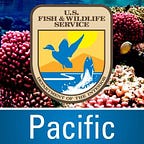Striving To Preserve Heritage and Culture — Marybelle Quinata
By: Jordan Akiyama, Public Affairs Specialist, U.S. Fish and Wildlife Service
Guam is an island located in the western Pacific. It is about 1,600 miles southeast of Japan and the southernmost island in the Mariana Island chain. Aside from being one of the first places in the world to welcome the New Year, Guam is an island diverse in wildlife and history and the park rangers of the Guam National Wildlife Refuge Ritidian Unit are dedicated to preserving both.
This part of the refuge, locally referred to as Ritidian, is known as Litekyan in CHamoru language. It is a place residents and visitors often come to fish, swim, and picnic at the beach. However, it is also a place rich with cultural heritage that has enabled archaeologists, students, and other community members to discover and reconnect with CHamoru history; and it is that connection that gives park ranger Marybelle Quinata so much pride in the work she does.
For Marybelle, Litekyan is about connecting to the past and preserving CHamoru heritage for future generations. Everyday at the refuge is another day to share her culture with those who visit.
“My favorite part is just being here at Litekyan, a significant place of my CHamoru heritage,” said Quinata. “To walk on the same land, swim in their waters, see ancient pictographs, and share it with others is personally fulfilling.”
The work that Marybelle and the rest of the staff do at Litekyan is important considering how much Guam’s natural environment has changed since just the 1950s. Stories told by elders spoke of a Guam that once saw birds, turtles, and fish everywhere. However, impacts of climate change and invasive species like the brown tree snake have resulted in a recent decline of the once thriving wildlife populations. Litekyan is also home to one of the oldest CHamoru villages, a place that connects CHamour people to their past.
“In addition to our conservation mission, preservation of the cultural resources of Litekyan, as an ancient CHamoru village remains invaluable to the people of Guam,” said Quinata. “Archaeological work done by Dr. Michael Carson, anthropology experts, and their students has helped our people uncover more about our ancient CHamoru ancestors and insight into their way of living. We protect the native and endangered wildlife and habitat as well as the cultural resources here, both of which make Ritidian so special to all our visitors.”
Since the emergence of COVID-19, Marybelle and the Guam National Wildlife Refuge staff have adapted to making sure guests of the refuge feel safe when they visit. In March 2021, Marybelle helped to orchestrate Ha’ånen Litekyan, an outdoor event at the refuge that allowed visitors to safely engage with traditional stories and while meeting wildlife and taking place in a scavenger hunt. The event was such a success that she collaborated with the University of Guam Press to celebrate Earth Month,
“We worked with other partners to host an event to promote the new children’s book ‘Mother Tree’ by Olympia Terral,” said Quinata. “The story is about the last Serianthes nelsonii on Guam. The program started with a reading by the author, a live animal exhibit to see a brown tree snake and Guam rail, and a walking tour to see plants and wildlife at the refuge. The tour ended at a Serianthes nelsonii sapling, where we gave a message of hope to do our best so that our Mother Tree isn’t the last Serianthes nelsonii.”
Passing on the history and how important nature is to that history is partially what motivates Marybelle to be an ambassador for her island. The other is ensuring that her children can experience the beauty of Guam rather than being told about it through stories. Ensuring Guam is preserved for the future is a responsibility that Marybelle feels that she owes to her grandparents and elders who came before her.
Recently, Litekyan has seen a resurgence of visitors amidst the pandemic as more families have come to the refuge looking for safe, outdoor activities. And while the refuge will always welcome visitors who want to enjoy the trails and beaches, Marybelle will continue to promote conservation in Litekyan and its CHamoru heritage. For anyone looking to visit, Marybelle would recommend they make one stop before exploring anywhere else on the refuge.
“I would recommend they visit the caves to see ancient CHamoru pictographs to connect with Guam’s cultural heritage,” said Quinata. “The pictographs and beauty of the area leave a powerful impression on many visitors.”
The U.S. Fish and Wildlife Service works with others to conserve, protect, and enhance fish, wildlife, plants, and their habitats for the continuing benefit of the American people. For more information, connect with us through any of these social media channels at https://www.facebook.com/PacificIslandsFWS, www.flickr.com/photos/usfwspacific/, or www.twitter.com/USFWSPacific.
